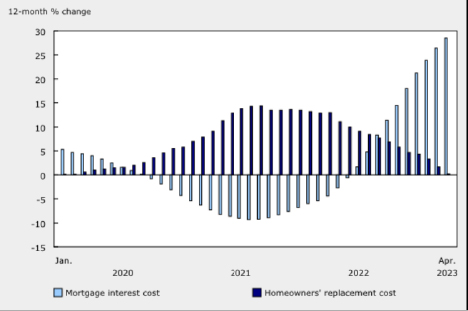|
In a twist of irony, the Bank of Canada’s interest rate hikes—meant to slow the economy and bring down inflation—are now one of the leading upward contributors to inflation.
Mortgage interest costs have skyrocketed following 450 basis points (4.5 percentage points) worth of Bank of Canada rate increase since last March.
As a sub-component of the consumer price index basket of inflation measures, mortgage interest cost was up 28.5% year-over-year as of April.
It’s a category that is now putting strong upward pressure on inflation. Another is homeowners’ replacement costs, which includes the cost of new homes, which was up 8.4% from last year, although its growth has been slowing due to the softening real estate market.
Other current contributors to inflation include food (+8.3%), gas (+6.3%) and rent (+6.1%).
Mortgage interest costs continue to accelerate

"Shelter costs (i.e., housing) are getting interesting at this stage, with a disinflation force now giving way to upward inflationary pressure,” noted BMO economist Robert Kavcic. "The mechanics of how housing filters into the CPI have long suggested this would be the case, but the firming of the resale market might now make the swing more notable.”
Kavcic said rises in rent (+6.1% year-over-year) and mortgage interest costs flow into CPI inflation readings gradually, but that "upward pressure there is now strong and persistent.”
In another note, BMO chief economist Douglas Porter was more direct: "Many will thus point to the BoC as the ’cause’ of inflation.”
"Base effects” about to impact inflation readings
On the flip side, headline inflation is expected to continue to ease thanks to comparative "base effects” from last year.
"Fading energy base effects will see headline inflation rates continue to ease in 2023,” explained RBC’s Josh Nye.
In the context of inflation, base effects refer to the impact of comparing today’s prices against those in the same month a year ago.
Food and energy prices cratered during the pandemic, which had the effect of inflating the following year’s annual comparison.
In the U.S., about 40% of June’s consumer price index reading could be due to base effects, according to Gregory Daco, Chief U.S. economist at Oxford Economics.
But economists say base effects should start to fall out of the headline inflation equation as year-over-year figures are compared against the economy post-pandemic. Core inflation, however, which strips out volatile food and energy prices, could prove more "sticky.”
"Core inflation is proving stickier and wage growth has picked up as labour markets remain resilient, suggesting it’s too early for central banks to declare victory in their campaigns to quash inflation,” Nye noted.
The next Canadian inflation report for May will be released on June 27.
|